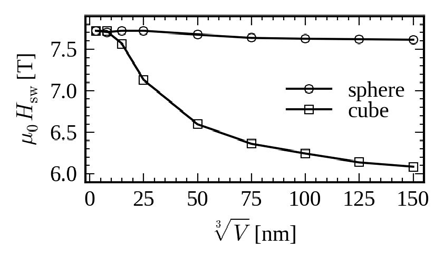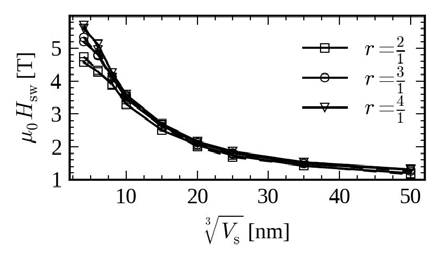Our paper titled “Micromagnetics for the coercivity of nanocomposite permanent magnets” has been published in the proceedings of the 23rd International Workshop on Rare Earth and Future Permanent Magnets and Their Applications (REPM2014). The proceedings were not made available to the public but we are providing a PDF reprint here.
 Fig. 1. Switching field of Nd 2 Fe 14 B cubes and spheres with volume V
Fig. 1. Switching field of Nd 2 Fe 14 B cubes and spheres with volume V
The work was presented by Johann Fischbacher on 19th August 2014 in Annapolis, Maryland.
Abstract:
Exchange spring permanent magnets may be a route towards high energy product permanent magnets with low rare-earth content. In composite magnets soft magnetic phases act as nucleation sites for magnetization reversal. We use micromagnetic simulations in order to understand the role of the size and shape of the soft inclusions on the magnetization reversal. We compare the switching field of magnetically soft spheroids, cuboids and cylinders embedded in a hard magnetic matrix. Whereas there is only little difference in the switching field for enclosed spherical or cubical soft shapes, prolate inclusions enhance the stability of the magnet.
 Fig. 2. Switching field of alpha -Fe cubes (solid line) and spheres (dashed line) with equal volume V s in a Nd 2 Fe 14 B spherical shell. r denotes the ratio of hard to soft magnetic volume.
Fig. 2. Switching field of alpha -Fe cubes (solid line) and spheres (dashed line) with equal volume V s in a Nd 2 Fe 14 B spherical shell. r denotes the ratio of hard to soft magnetic volume.
 Fig. 3. alpha -Fe cubes (solid line) and spheres (dashed line) enclosed by a 1 nm interlayer in a Nd 2 Fe 14 B spherical matrix. The interlayer exchange constant A_i =fA_hard is reduced to decouple inclusion and shell. Open markers refer to the soft phase reversal field and filled markers to the hard phase switching field.
Fig. 3. alpha -Fe cubes (solid line) and spheres (dashed line) enclosed by a 1 nm interlayer in a Nd 2 Fe 14 B spherical matrix. The interlayer exchange constant A_i =fA_hard is reduced to decouple inclusion and shell. Open markers refer to the soft phase reversal field and filled markers to the hard phase switching field.